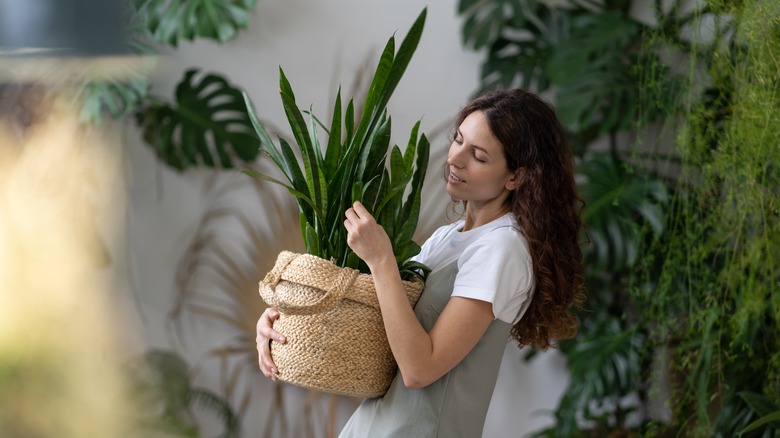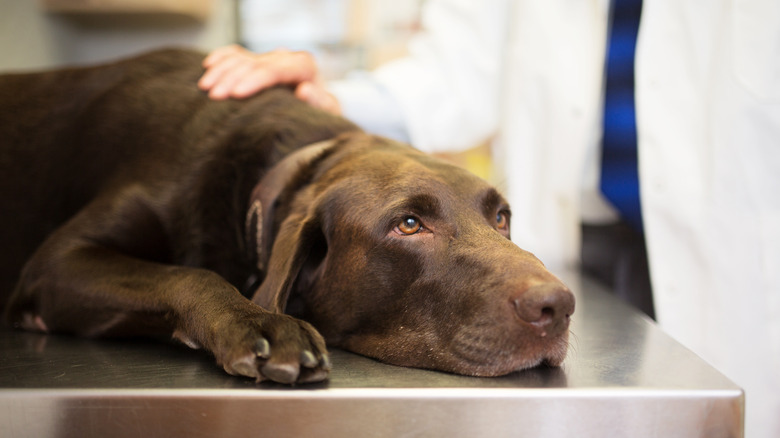Pet Parents Should Be Wary Of Growing This Popular Houseplant
One of the best things you can do for your home is to grow a garden. Not having yard space doesn't disqualify you from being a future gardener. There are tons of easy houseplants you can grow indoors so that you get to have a touch of green life among your other points of decoration. If you have pets, however, some plants may not be suitable for you to keep in the house.
Snake plants (Sansevieria trifasciata) are a common variety of houseplants and a go-to choice for homeowners and gardeners everywhere because of their gorgeous foliage. However, these green beauties are poisonous to your dog or cat thanks to two compounds contained in their leaves called saponin and glycosides, but especially the former.
Like other houseplants, snake plants make a tasteful addition to your home, not only because are they ornamental, but because they also purify the air and they're very low maintenance. One issue you should know before growing snake plants, however, is that the presence of the phytotoxin saponins in their leaves can spell disaster if you have pets. Saponins in snake plants can cause stomach and bowel issues, such as vomiting and diarrhea. They can also lead to hypersalivation and dilated pupils.
On the bright side, while snake plants are harmful to your furry friends, you can side-step the bad plants and only grow safe alternatives.
Grow alternative plants that look like snake plants instead
The poisonous snake plants come from the genera Sansevieria and Dracaena. The phytotoxins in snake plants reside in the leaves which, when ingested by your pet, can lead to severe abdominal distress and other symptoms. There are a couple of ways you can prevent this and ensure your fur babies don't come in contact with snake plants. You can either grow alternative plants that resemble snake plants, but without the toxic quality, or you can still grow snake plants and keep them out of your pet's reach.
If you love the look and quality of snake plants, then you can rest assured that you don't have to stray from the Asparagaceae family to find a non-toxic plant for your home. Spider plants (Chlorophytum comosum) give off the same vibe as snake plants and have wilder foliage that resembles spiders if they had 100 legs instead of eight. Peacock plants (Calathea makoyana) have shorter, rounder leaves, but they are equally stunning with their elaborate green designs and splotches.
Meanwhile, the ponytail palm (Beaucarnea recurvata) isn't in the same family as snake plants, but they offer a unique tropical look that would elevate the décor in your home. It's also a houseplant that anyone can keep alive, as it is hardy and doesn't need a lot of maintenance.
What to do if your pet eats snake plant leaves
If you insist on keeping the snake plants in your house, then you have to keep it out of reach of your pets. Place the pots in locations that are out of reach for pets, like on top of your bookcase or shelves, or hang them from the ceiling using a rope. With dogs, this would be easy. They aren't likely to jump up on your bookcase or even reach the hanging plants. However, cats are more agile and can parkour their way up there just for fun and giggles. Having a cat means that no territories are actually out of bounds, so moving your snake plant probably won't work on them. This also means that your outdoor garden should be snake-plant-free as well.
If your pet does manage to eat a few snake plant leaves and gets poisoned as a result, the first thing you should do is keep a calm head and contact the Animal Poison Control Center by calling (888) 426-4435. If you can, you should also drive your pet to the nearest veterinarian for a checkup. This is a great idea if you aren't 100% sure that they actually consumed your snake plant leaves, but they are exhibiting the symptoms of it. Eating snake plants isn't typically fatal, so with the right treatment, your furry friend may be just fine.


